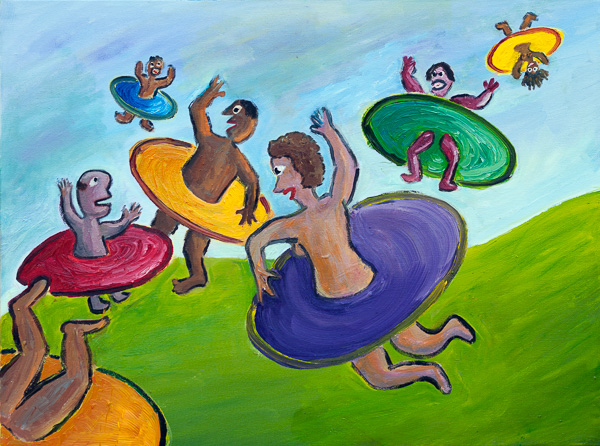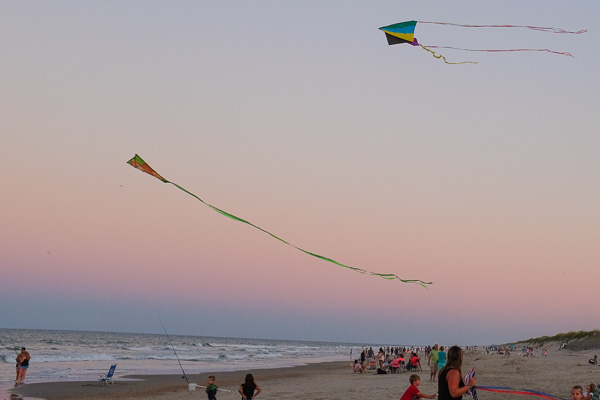I’m working a lot on my novel Million Mile Road Trip these days. It’s about half done, and I started last January, eight months ago, so I might finish it June, 2016.
I did revisions for most of August, making the plot much clearer and more focused. And now I have an elevator pitch.
Three teens on a million mile road trip across a landscape of alien civilizations. Goal? Stop the flying saucers from invading Earth. And learn about life and love.

“Saucerpeople” oil on canvas, Sept, 2015, 24” x 18”. Click for a larger version of the painting.
The saucers in my novel are living organisms, meaty flying things. And *eeeek* it is in principle for a female saucer to fertilize her seeds with human DNA. They can get the DNA just by kissing a boy—I’m holding back from full-on sex between men and saucers.
So a saucer gets pregnant from a man or boy, lays some fertilized eggs, hatches them…and you get saucerpeople, as shown above! The have saucer-like rims around their waists, and they can fly.
I’m looking forward to writing some scenes with these guys. My plan had been to postpone them till later in the book but—why hoard the treats? Maybe I can work a saucerperson into the chapter I’m working on right now, “Surf World.”
The Surf World basin is edged with high, crumbly cliffs and a wide beach. And from there on out, it’s nothing but ocean. With insane, unnatural surf. Huge glassy combers, lively little pup tents scooting off at angles, and—weirdly enough—giant staircases and glassy pyramids. All made of water. Way out to sea are some waves like mile-high walls, thin and wobbly, steaming along like express trains. Most of the waves are heading away from the shore, and out to sea—which is kind of scary and strange. Catch one of those suckers, and you’re not coming back.

I’ve written several SF stories about surfing with Marc Laidlaw. And recently I was inspired by a big wave on the so-called “Miller’s world” in the movie Interstellar. Generally I feel that you shouldn’t model your novel’s kicks on things you saw at the movies. But that Miller’s world wave made a big impression on me. Terrified me, sitting in the movie theater.
I looked online and found the movie’s consulting physicist Kip Thorne’s ideas about the wave, lifted from his interesting book, The Physics of Interstellar. His explanation is way more complicated than I expected. No surprise, as Thorne is a brilliant physicist—I first encountered his work in the 1973 nonfiction tome Gravitation, by Kip Thorne, John Wheeler, and Charles Misner, a book that was heavy in every sense of the world—and which had a big influence on my SF and science writing.

Thorne’s line is that Miller’s world is “tidally locked” to a supermassive black hole that it’s orbiting—locked means that it rotates in synch with the orbit so that the same side is always facing the central black hole. (Our moon is tidally locked to Earth, and thus we always see the same face of the moon.)
Using “tidal” in a different sense, note that the tides on a planet are in fact bulges that are taffy-pulled up by the gravity of the sun (or black hole) that they orbit. And there’s one tidal bulge on each side of the planet. And (handwaving a bit) given that the black hole’s gravity is so extreme, the tidal bulges might be a mile high and only a hundred meters thick. But if the planet is tidally locked (tidal in the other sense now), then that tidal bulge won’t be moving relative to the planet’s surface. It’s static.

So now Thorne adds the assumption that Miller’s world is nearly locked into position, but it does wobble a bit back and forth, like maybe an hour per wobble. And as it wobbles, the giant wave-wall sweeps back and forth like a windshield wiper. The ocean sloshes, you might say. And this would explain how one of those waves might rush in either direction…including away from the shore.
But…I don’t want to get into explanations like this. Too classroom. I always hated doing Physics homework in college and, truth be told, I wasn’t good at it. No, I don’t want my rubber science to be off-the-shelf physics-homework science. I want insane bullshit that nobody’s ever heard of. Also it’s my sense that biotech, hylozoism, and the philosophy of computation are more interesting these days than old school general relativity.

So, okay, in Million Mile Road Trip, I have this stuff that I call smeel. It’s like an aethereal fluid that “is” consciousness. Smeel is the numeniferous aether, if you will—given that “numen” is Latin for “divine essence” or “magical power” or even “soul.”
As it happens, flying saucers like to vampirically leech smeel from us. They drink your smeel, and then you’re like a like a zombie. Note, by the way, that those sacuerpeople I talked about earlier are not necessarily down with the evil smeel-leeching of the mainstream saucers. Indeed some of the saucerpeople are going to serve as double agents to help my teen heroes avert the impending Invasion of the Saucers!

Anyway, it occurred to me that I can pep up the waves in my planet-sized Surf World sea by saying that the sea happens to be ten percent smeel. Not just water. And because of all this smeel, the waves are conscious and alive.
The smeel makes the waves playful. They race each other across the ocean. They pile way up on the far side, and then they race back. They take on shapes like staircases. It’s a totally surreal Mandelbrotian landscape. My character Villy gets lost and a friendly saucerperson shows up and guides him to his girlfriend Zoe and the rest of his gang.

In using smeel to animate the waves, I’m reprising an idea that Marc Laidlaw and I used in our latest surfing SF story, “Water Girl” — which appeared in Asimov’s in August, 2014, featuring, as usual, our characters Zep and Del.
Like why should I copy a Hollywood movie? Better to copy a story by Rucker and Laidlaw!
In “Water Girl,” it’s a substance called quantum aether that gives the waves consciousness. And the waves are alive, running their mental processes off quantum computations. The mad scientist in our story wrote a paper called “The Quantum-Aethereal Animation of Physical Fluids.” Here’s an extract from that story that I plan to draw on.

Stink Bay was teeming with small, erratic waves, three to five-footers … astir with frolicking shapes, powerful energetic forms that cut through the water like—well, like other water. Waves peaked from the flat surface, curled and gathered a bit of foam at their crests while cupping blue-green darkness at their long tubular hearts. The waves travelled without breaking, moving straight toward the shore then peeling away at clever angles, gouging divots out of the mud and sand. Small forms glided alongside the larger ones, and the “calves” word clicked for Del. The little waves reminded him of whale calves at play near a mother whale…The anomalous hump in the water began gliding towards the Pipeline, a shape like you’d see if something were swimming below the surface. The calf waves were herding…Zep and Del in the thing’s wake, pushing them out towards the unquiet open sea.

Squiddy detail of a painting by Robert “El Rey Magnifico” Williams.
Changing the subject again, shown below is a painful painting I did in August. I won’t go into great detail, but suffice it to say that I may need to get a “revision” operation on an artificial hip implant. It’s situationally depressing. In doing the painting below, I was doing kind of a Frida Kahlo routine—she used to do paintings of herself getting operations. If you do a painting like that it makes you feel better. And at least you’re getting some art out of your bad experience.

“X-Ray of Failed Hip Implant” oil on canvas, Aug, 2015, 18” x 24”. Click for a larger version of the painting.
Flickering flames of pain. I’m glad to be able to paint about it, and I’m glad I have a novel to work on. Writing takes my mind of any worries and cheers me up. It’s soothing to retreat into my own little worlds. Away from so-called reality. “No news is good news.”









September 15th, 2015 at 3:18 pm
Looking forward to reading Million Mile Road Trip, Hurry up! It’s been a long time since your last book. Did you see the flying saucer that was discovered in the Baltic sea? It’s a nice example of life imitating art.
September 15th, 2015 at 3:29 pm
Glad you like, Alex. “A long time since your last book”? Cut me some slack…I did THE BIG AHA (new novel) in 2013, TRANREAL TRILOGY (antho of three old novels) in 2014, a new edition of ALL THE VISONS (memoir) in 2014, and JOURNALS 1990-2014 in 2015. But you know this, if memory serves, you’ve backed Kickstarters for some of my books, discerning man that you are.
Not sure if MILLION MILE ROAD TRIP will be out in 2016 or if it’ll take till 2017, but I’m cheered that you’re telling me to hurry up! I do plan to publish via Transreal Books an antho of my 9 stories with Bruce Sterling in February, 2016, it’ll be called TRANSREAL CYBERPUNK, and will include one brand-new never-published story, plus notes by me and by Bruce, plus an intro by an SF scholar. I’ll be talking more about this one later this fall.
Didn’t hear about the Baltic UFO. A discus?
September 15th, 2015 at 3:47 pm
Looks like the Baltic UFO
https://en.wikipedia.org/wiki/Baltic_Sea_anomaly
is just a pareidolia effect.
2017 for Million Mile Road Trip? I can’t wait that long…!
Get on with it! 🙂